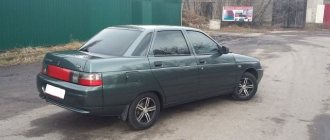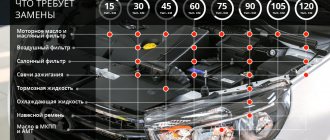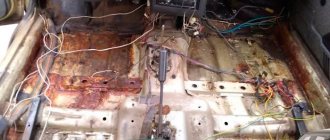Serial production of the VAZ 2114 lasted from 2003 to 2013; the car continued the line of VAZ “nines” and became its restyled version. The five-door hatchback received updated front body lines, new headlights, and moldings.
Structurally, the Lada Samara of all years of production was built on the same platform as the VAZ 2109; the model received universal engines, an all-metal body with attachments. Considering that the car has been out of production for almost seven years, replacing VAZ 2114 thresholds is one of the most common types of body repairs today.
In what cases is threshold repair required?
The main reasons why threshold repair is required include:
- Corrosion due to exposure to chemical reagents;
- Incorrect use of the jack;
- Sloppy parking on the sidewalk;
- Road traffic accident;
- Careless driving on rough terrain.
Because of all this, dents, scratches and areas damaged by corrosion can form on the thresholds.
Preparing for replacement
For the entire VAZ family, thresholds are non-removable body elements; in 80% of cases, repairing an element involves completely cutting or cutting out the part. Overcooking requires preparation
- The car is installed on a flat surface.
- The negative terminal is removed from the battery. In some cases, the battery is removed.
- The wiring from the inside of the doors from the electric windows is dismantled, all sensors are removed.
- The seats are removed from the interior, the inner trim of the pillars and the floor covering are removed.
- Doors are dismantled.
When planning to repair only the threshold, drivers have to partially change the bottom, install new jacks, and strengthen the central pillar. The metal for the body of the VAZ 2114, as well as for other models in the Lada Samara line, did not undergo anti-corrosion galvanizing.
Rolled steel was puttied, primed and painted. The inner part of the bottom and the box were not treated with anticorrosive; the first layers of rust appear on the internal parts of the body in the second year of operation. If the threshold is being repaired for the first time, and the “youngest” VAZ 2114 model is 6 years old, we can confidently say that the owner will find completely rotten metal under the bottom trim.
To prevent the geometry from becoming distorted during repairs and the central pillar from falling, it is recommended to install spacers or weld a channel.
How are car sills repaired?
Sequence of work for removable thresholds:
- Dismantling. The thresholds are removed by unscrewing the bolts that hold them in place;
- Elimination of deformations. The threshold is returned to its previous shape;
- Metal thresholds are treated with an anti-corrosion compound so that the repaired threshold is not destroyed due to exposure to an aggressive environment;
- Painting. At the final stage, paint is applied so that the threshold has a beautiful appearance.
List of works for fixed thresholds:
- Damaged areas are “stretched” to return them to shape. In case of serious defects, it may be necessary to dismantle and install a new threshold;
- At the last stage, anti-corrosion treatment, masking of welds, priming and painting are performed. Additionally, the threshold can be coated with anti-gravel.
What is this?
By overcooking car sills we mean tuning the body part of a car by a master in order to restore the presentable appearance of this element and give it protective functions. Overlays are usually made of plastic or metal. Plastic is an unaesthetic and impractical material. Therefore, metal sheets are more often used.
Thresholds prevent the formation of dents, abrasions and cracks in the space under the doors. Therefore, when they wear out, repairs are simply necessary. Typically, recovery is carried out by overcooking. For this purpose special tools are used. The work is troublesome and painstaking. There is a risk of damage to the door lock motor. Therefore, it is better to trust the overcooking to service station professionals.
If repair of the linings is required, the motorist needs to do a number of the following actions:
- Choose a service station that specializes in restoring cars of a specific brand.
- Call the administrator and clarify all the terms of cooperation, the approximate cost and deadlines for completing the work.
- Bring the car to a car service center at the time agreed with the technician.
- Wait until a specialist inspects the vehicle.
- Find out the exact price of the work.
- Agree to overcook.
- Wait for the repair to be completed.
- Evaluate the quality of work.
- Pay the auto mechanic for his work.
The wizard’s work follows the following algorithm:
- Inspection of the damage to the threshold.
- Removing the cover.
- Removing the entire element or damaged part by cutting.
- Cutting patches from high-quality metal.
- Welding the cut part to the thresholds.
- Cleaning the trim.
- Coating it with a protective compound or film.
- Installation in place.
Typically, a car mechanic uses a semi-automatic spot welding machine to repair the trim.
How much does it cost to repair or replace thresholds?
The price of threshold repair is determined individually. It is necessary to inspect the damage and draw up a list of work to eliminate it. Based on this, the cost will be determined.
If you need threshold repair in Moscow in the Northern Administrative District, call us to make an appointment and come at a time convenient for you. We will offer you favorable conditions, and you will be able to receive a repaired car in the shortest possible time.
What does the price depend on?
Different car repair technicians perform over-welding of car sills for different amounts of money. The price is formed under the influence of various factors:
- Type and area of damage.
- Repairability of the lining.
- Threshold material.
- The number of thresholds that need to be digested.
- Welding method.
- Price of consumables.
- Car model and make.
- Need for dismantling.
- Urgency of work completion.
- Additional work (straightening, painting, gluing protective tape, treatment with a special compound, reinforcement).
- Price for a specialist visit.
Advantages of the Master-Kuzov body shop
- The best prices for threshold repairs in the Northern Administrative District. Many of our clients constantly turn to us because they are satisfied with prices and quality;
- Discounts. We offer good discounts to regular customers. Details can be obtained by contacting us by phone;
- Guarantee. We are absolutely confident in the quality of our services and provide a good guarantee for threshold repairs;
- No queues. The capacity of our auto repair shop allows us to serve customers without queues;
- Experience. Many of our technicians have been repairing cars for at least 10 years;
- Short deadlines. Depending on the complexity, threshold repair can take up to 48 hours.
We are ready to answer any of your questions related to the repair of thresholds in the Northern Administrative District. Contact us by phone to get a free consultation and take advantage of our services.
Price-list
In Russia, it will cost about 5,000-15,000 rubles to digest one threshold in a car. This cost may include the following work:
- Welding – from 5,000 rubles .
- Straightening – 3,000 rubles .
- Painting – from 3,000 rubles .
- Installation (removal) of the lining - from 2,000 rubles .
- Production (reworking) of thresholds to order and their installation - from 10,000 rubles .
- Reinforcement of the lining - from 4,000 rubles .
Departure of a specialist to the location of the car and urgent work are paid additionally. The final price in this case is negotiated individually.
What cars do we work with?
Repair and painting for all popular car brands
Acura
Alfa Romeo
Audi
BMW
Bentley
Cadillac
Chevrolet
Chrysler
Citroen
Dodge
Fiat
Ford
Genesis
Hummer
Honda
Hyundai
Infiniti
Jaguar
Jeep
KIA
Land Rover
Lexus
Lincoln
Mazda
Mercedes
Mitsubishi
MINI
Nissan
Opel
Peugeot
Porsche
Renault
SEAT
Saab
Skoda
SsangYong
Subaru
Suzuki
Toyota
Volkswagen
Volvo
Lada
How to cook thresholds on a VAZ 2114
If the sills on a VAZ 2114 are rotten, in addition to replacing the main element, you will also have to re-weld the bottom by cutting out the old metal and installing patches. Step by step process:
- The connector or the lower part of the box is welded.
- The amplifier is installed.
- The outer part is welded by arc welding.
- Welding seams are cleaned with a grinder, primed and puttied.
- After 12 hours, anti-corrosion agents are applied to the bottom and outer part, and at the final stage, painting is carried out with auto enamel.
It is not recommended to operate the car for 24 hours until the paint has completely dried.
All about dismantling and replacing car thresholds
Replacing thresholds is one of the most common types of body repairs that every driver has to deal with, regardless of the year of manufacture of the car and the make.
The elements belong to the decorative and power parts of the body, provide a comfortable fit and are the first to be subject to wear and mechanical damage due to improper parking, from impacts with gravel, or when driving on bad roads.
What are the defects?
According to the type of attachment to the supporting body, the thresholds are classified into removable, which are installed on the body with bolts, and non-removable. The elements are welded to the sidewall and provide the car structure with the necessary rigidity and reinforcement. Regardless of the type of installation, the elements suffer the same damage.
- Dents. Defects are formed from impacts with gravel, careless parking, or as a result of a minor accident. Mechanical damage from gravel damages the outer part of the underbody, wheel arches, and side members.
- Scratches, chips. The outer part is damaged. The defect does not affect driving safety; the appearance of the car suffers.
- Corrosion. Rust occurs due to natural wear and tear of the metal and due to improper processing or lack of anti-gravel protection. The degree of wear affects driving safety. If the non-removable threshold, as part of the power element of the body, rots, the overall geometry of the structure changes, the main components and assemblies are distorted: the engine and transmission elements.
Repair technology
Fixed thresholds are repaired in two ways: with or without welding. The method of sealing holes in the outer cover of an element with a soldering iron is not recommended either by experienced drivers or service station technicians. After soldering, the process of electrochemical corrosion begins on the metal, as the structure of the metal of the patch and the base is destroyed. You can solder the threshold in exceptional cases, not forgetting that this is a temporary measure that will require a complete reinstallation of the part in 3-6 months.
It is also recommended to use fiberglass to seal through individual corrosion plaques in exceptional cases. This is a short-lived cosmetic type of repair that does not provide reliable structural rigidity. Repairing car thresholds with epoxy glue and fiberglass in steps:
- Use a grinder to cut off the old paint and clean the area of corrosion.
- Treat the surface with a rust converter and sand it with sandpaper.
- Dilute the epoxy resin, be sure to add aluminum or copper powder to the glue.
- Cut 3-7 patches from fiberglass with an area slightly larger than the hole to be repaired.
- Apply epoxy slurry to the surface and apply a patch.
- Coat the repair area and apply fiberglass in several layers.
- Roll with a rubber roller, remove air and excess glue.
Epoxy glue dries in 24-36 hours. After this, it should be cleaned with medium abrasive sandpaper, primed and painted.
The best method of repair remains welding; how to digest thresholds depends on the degree of damage to the element. It is recommended to use electric welding using a carbon dioxide semiautomatic device or an inverter. Gas welding using electrodes is a rather complex type of work, since it is necessary to have extensive experience and practical skills in order not to burn through the metal and lay a high-quality seam.
Square pipe instead of thresholds on a VAZ
To change the thresholds on a VAZ 2114 with your own hands, in half of the cases profile pipes are used. This method has proven itself well when replacing similar parts on classic VAZs. The profile has suitable dimensions of width and height, and the metal thickness reaches 2 mm, which ensures the reliability of the body for at least 7 years. In addition, profile pipes in 40% of cases have an additional zinc coating, which ensures the metal’s resistance to corrosion.
To work you will need:
- profile pipe 60x60x2 mm: 180 cm for one threshold, 70 cm for the cross member that will connect the spar to the part;
- profile with dimensions 40x20x2 mm: 70 cm for an additional cross member, 25 cm for jacks, if you have to reinstall the old ones;
- metal plate 15x5 cm to strengthen the part to the bottom;
- anticorrosive for the bottom - bitumen mastic 500 g;
- Bulgarian;
- electric or gas welding, 3 mm electrodes.
Experienced drivers recommend not using an inspection hole, but putting the car on its side, having first removed the battery, door, seats, and interior trim.
- Remove moldings and panels.
- Using a grinder, cut off the outer part along the top seam and bend the metal.
- Cut off the inside, remove the amplifier.
- Attach the pipe, cut off the excess part, weld plugs at the ends of the profile.
- Tack the profile to the bottom by welding at two points, front and back.
- Boil the outer part of the profile to the body, moving from the central pillar. If the body has a bend in this area, tap the pipe during welding to align the profile.
- Weld the cross members that will connect the threshold and the spar.
- Weld fasteners under the jack, weld plates to the bottom to strengthen the structure.
- Clean the weld seams with a grinder and treat with mastic.
- Paint and install decorative panels.
Power profile thresholds have maximum resistance to mechanical damage. If the original body elements bend under a strong impact, for example when driving incorrectly on a difficult section, on potholes, etc., then with installed profiles only the paintwork and plastic linings will suffer.











